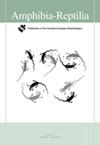Evaluation of locomotor activity in female Chelonoidis chilensis (Testudinidae, Gray 1870) in response to artificial photoperiod and temperature treatments
IF 1.3
4区 生物学
Q3 ZOOLOGY
引用次数: 0
Abstract
Turtles as many other reptiles are capable of orientating their bodies toward the sun. This conduct requires the presence of an internal biological chronometer in the organism that regulates this behavior. Thus, a description of the internal clock in these reptiles is of interest. The assessment of locomotor activity can be considered a reliable indicator of biological clock function. This study aimed to investigate the effect of different artificial photoperiod and ambient temperature schedules on total locomotor activity of female Chelonoidis chilensis and its rhythmicity. Six C. chilensis specimens were exposed to different artificial photoperiods and temperature regimes each fixed for seven days. It was observed that the activity period during the different experimental schedules was close to the 24 hours indicating a daily rhythmicity. Moreover, all tortoises showed a similar total locomotor activity pattern displaying the most of motion during light phase. Under the condition of constant light tortoises exhibited a self-sustaining rhythm not entrained to light and temperature zeitgebers, thus, suggesting its possible endogenous periodicity. Though this study deepens the knowledge on the rhythmic system of C. chilensis, further investigations are needed to achieve a more detailed understanding of tortoise biological clock.雌性中华绒螯蟹(testudinae, Gray 1870)在人工光周期和温度处理下运动活动的评价
海龟和许多其他爬行动物一样,能够将身体朝向太阳。这种行为需要生物体中存在一个调节这种行为的内部生物计时器。因此,对这些爬行动物体内生物钟的描述是有意义的。运动活动的评估可以被认为是生物钟功能的可靠指标。本研究旨在探讨不同人工光周期和环境温度对雌性红螯虾总运动活动及其节律性的影响。6个辣椒标本分别暴露在不同的人工光周期和固定温度下7天。结果表明,在不同的实验时间内,脑活动周期均接近24小时,具有一定的节律性。此外,所有陆龟都表现出相似的整体运动活动模式,在光阶段运动最多。在恒定光照条件下,陆龟表现出一种不受光照和温度授时因子影响的自我维持节律,表明其可能具有内源性周期性。虽然本研究加深了对chilensis节律系统的认识,但还需要进一步的研究来更详细地了解乌龟的生物钟。
本文章由计算机程序翻译,如有差异,请以英文原文为准。
求助全文
约1分钟内获得全文
求助全文
来源期刊

Amphibia-Reptilia
生物-动物学
CiteScore
3.10
自引率
6.20%
发文量
39
审稿时长
6-12 weeks
期刊介绍:
Amphibia-Reptilia is a leading European multi-disciplinary journal devoted to most of the aspects of herpetology: ecology, behaviour, evolution, conservation, physiology, morphology, paleontology, genetics, and systematics.
Amphibia-Reptilia publishes high quality original papers, short-notes, reviews, book reviews and news of the Societas Europaea Herpetologica (SEH). The Societas Europaea Herpteologica (SEH) website is located at: www.seh-herpetology.org.
 求助内容:
求助内容: 应助结果提醒方式:
应助结果提醒方式:


